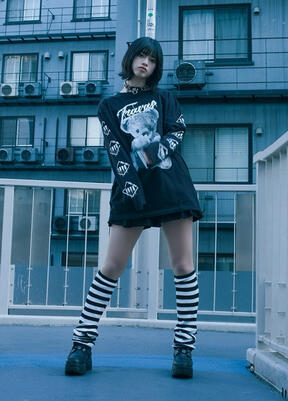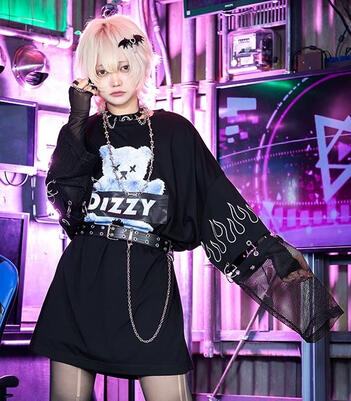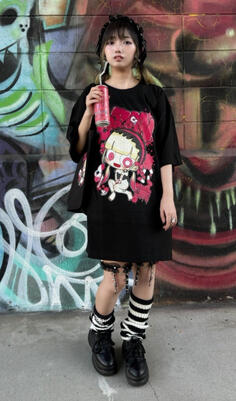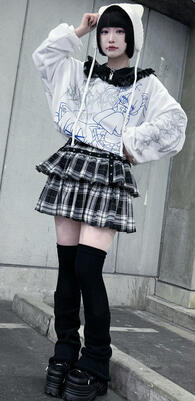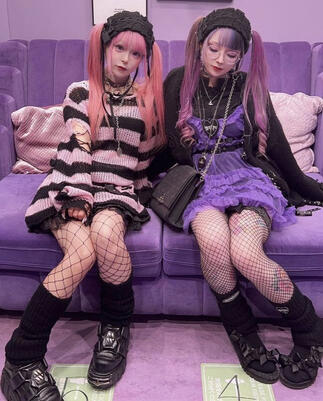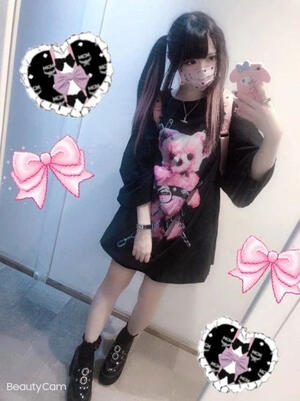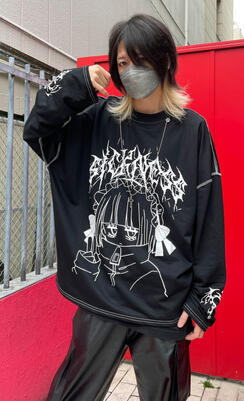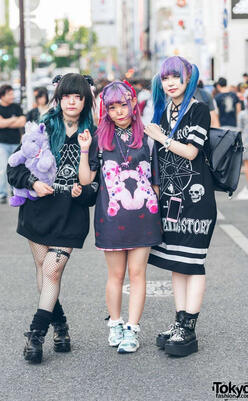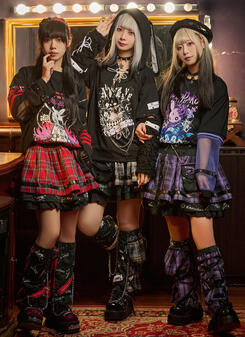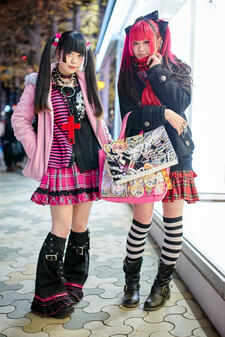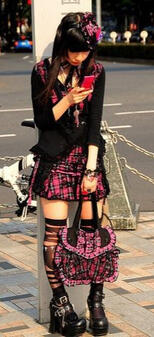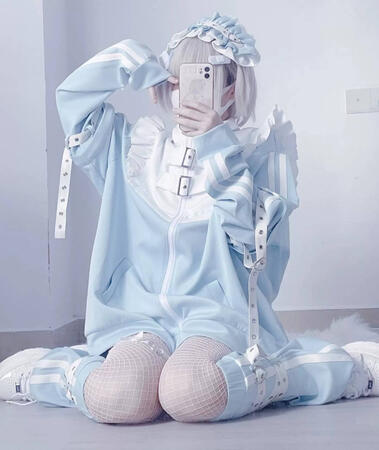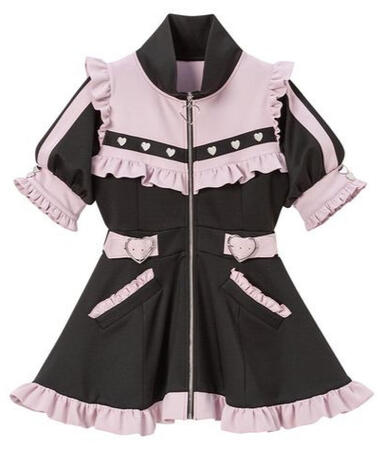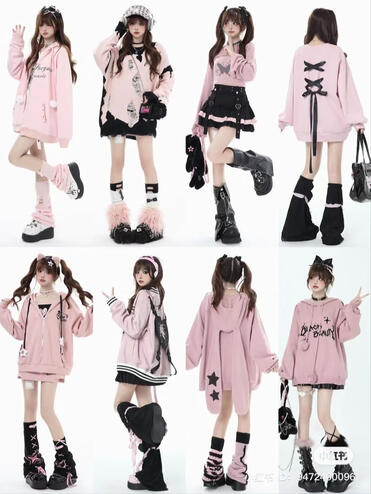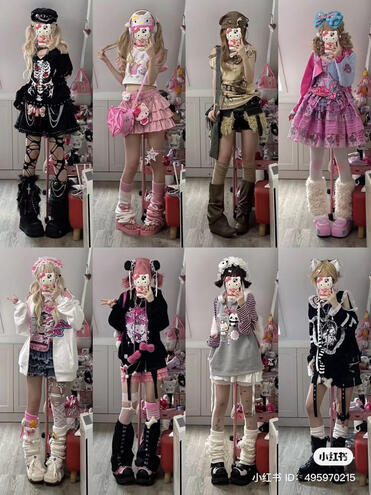menherajiraiinfo.carrd

X

Menhera and Jirai-kei
When people think of jirai-kei, they often have a very specific image in mind of a cute fashion with a dark side. This sounds similar to menhera, which also has a fashion aspect. I wrote this to give some background on jirai-kei, dispell some common misinformation and summarize the difference between jirai-kei and menhera.
Some of this may be biased because it is written from the perspective of someone in the western menhera community who has witnessed a a large part of the rise of jirai-kei in the west and some of its effects, often negative, though I am not against the existence of jirai-kei. I have listed all my sources at the bottom, I highly recommend the first doc.
To learn more about menhera, please go here!

Common looks associated with jirai-kei
Firstly, to summarize the difference between jirai-kei and menhera:
Menhera is a term created by the online mental health community for people struggling with their mental health for the purpose of connection, while jirai-kei is a term for a particular negative stereotype that has evolved into it's own subculture.
Menhera is pro recovery, while jirai-kei ranges from neutral to anti recovery (for oneself).
Menhera is a subculture as well as a fashion, while jirai-kei is a subculture that has adopted multiple pre existing fashions and styles.
This carrd might be a bit long, but I've done my best to explain everything thoroughly!
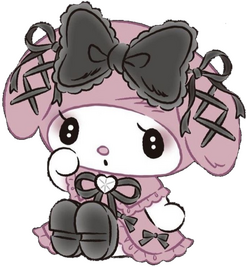
♡ Origins ♡
Jirai-kei directly translates to "landmine-type," and can be interpreted as having a similar meaning to something like "psycho bitch". It refers to someone, usually (but not limited to) a woman, who is easily triggered, and will blow up and become abusive over small things. The term has existed since at least the 90s, usually used by mysoginist men to warn other men about dating red-flag women, based upon a variety of harmless traits. Starting in 2020 after a "landmine makeup challenge", the stereotype became more solidified as a certain specific look and went viral.
The original "jirai-kei" look from 2020 is inspired by the "Toyoko Kids," a group of young homeless people in the Shinjuku red-light district of Kabukicho. The Toyoko Kids, being young runaways in a red-light district, often influenced by the worst people around them (most infamously the late Howl Kalashnikov, a whole rabbithole of his own), are associated with underage prostitution, host club addiction, public drug use, alcoholism, public cutting circles, and violent delinquent behavior. Many of them would wear alternative fashions. Girly-kei became popular among women in the group, sometimes because it would make them "look more expensive" as customers at host clubs (especially the MCM bags), or appeal to others in the group. It should be noted that the Toyoko Kids are simply a group of young, vulnerable people, failed by their families and by the system, often trapped in the dangerous spiral of addiction and/or debt, and not all of them are bad or dangerous people. The stereotype comes from the most extreme behaviors that were filmed or reported on and went viral. Nowadays, the area around the Toyoko theater has been fenced off and there are less of them than before. However, they are what the modern stereotype parodies.

♡ Fashion ♡
Many brands around 2020 began to capitalize on the trend and began selling pink x black girly-kei fashion labelled as "Jirai-kei" in order to not miss out any of the youth's latest buzzwords. It should be noted that not all brands did this, and many refused to use the word to describe their clothing due to finding it offensive. However, this did not extend solely to girly-kei, as later on some brands would also start to label other fashions as jirai-kei to boost sales. Menhera, goth punk, jersey maid and yamikawaii have also been lumped in with "jirai-kei," along with cyber fashion and dark casual streetwear in general. I have also seen some styles of cfashion be called jirai-kei.Girly-kei as a fashion has existed since around 2010, with a variety of substyles. Yamikawaii has been around for a while, but it got it's name in 2015. The association of these styles with the stereotype and subculture has been extremely harmful to people who simply enjoy wearing the styles, especially girly-kei and the dark girly substyle as it is the main one associated with the image of jirai-kei.Jirai-kei is NOT a fashion, and also does NOT have one singular look, as it is an amalgamation of other pre-existing styles as they trend.Here are some examples of styles not within girly-kei that I have seen labelled as jirai-kei online:
Examples of Yamikawaii styles that have been associated with jirai-kei. It's popular with menhera as well.
Side note, the association of yamikawaii with pastel pink medical motif outfits is a result of Ezaki Bisuko trying to erase menhera fashion and rebrand yamikawaii, the original yamikawaii is different.
Goth punk and jpunk have also been associated.
I have also seen techwear, cyber styles, and tracksuit inspired fashion like jersey maid be called jirai-kei when y3k was at it's peak.
Some random examples of cfashion/chinese alternative fashion. Many cfashion styles might also fit in or overlap with japanese alternative fashions! I have seen some pictures of cfashion get labelled as jirai-kei sometimes when people cannot exactly pinpoint the original fashion, and a lot of taobao brands also use the term landmine for reach.
A lot of times in jfashion the boundaries of what is considered part or not part of a fashion are pretty loose and allow for creativity (unless there are strict guidelines), which means that the way that girly-kei was adopted within jirai-kei is still considered girly-kei, as it is not really different enough from dark girly to be it's own thing. The same thing applies to every other fashion that has been associated with or adopted by the jirai-kei subculture.How does this differ to menhera fashion? Sometimes, menhera fashion is also based off trending styles. However, the main focus of menhera fashion is often vent prints styled in a way that is comfortable and not too over the top, which makes it identifiable. This style was created from the community. As for jirai-kei, it generally adopts pre-existing alternative fashions in their entirety as they trend, but does not have it's own fully original fashion or unique identifiable features as a fashion.
Drawing by lovecoutorn showing the changes over time in outfit styles associated with jirai-kei, added here as an example of how it changes a lot over time and does not have one set style.

♡ Why Labelling the Fashion as Jirai-kei Can Be Harmful ♡
Calling the fashions adopted within jirai-kei as "jirai-kei" can be dangerous. Often times, people will label every fashion popular with the subculture as jirai-kei, like an umbrella term to simply mean "fashions that jirai-kei wear". Even though this isn't done with ill intent, it has caused confusion and harm.The main concern is that young or vulnerable people who find the outfits cute may stumble upon the subculture and get exposed to a variety of risky and harmful things. This is not a "think of the kids," it is more to point out that the jirai-kei subculture by nature can be really harmful to people who don't already fully have the mindset of not wanting to recover/not caring about recovery. A lot of people find the subculture through the clothes first, and some people may feel like they have to do the behaviors associated with jirai-kei to fit in and be a proper jirai.Not just that, but people who wear the fashions outside of jirai-kei, or worse, were wearing them before jirai-kei became a thing, often have to deal with incorrect assumptions and even harassment. Many people feel extremely uncomfortable or insulted by being associated with jirai-kei if they are not part of the subculture.
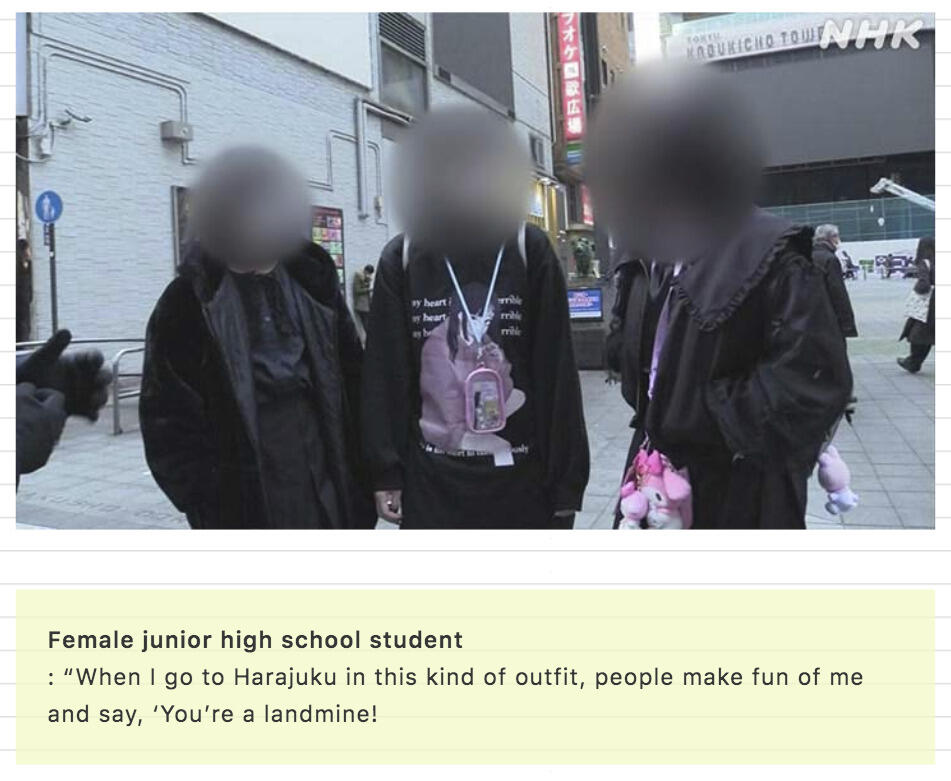
There is also the fact that many jirai-kei themselves are adamant that jirai is not a fashion. Many find it offensive to call it a fashion, because to them, jirai-kei is something deeper, and it may feel like their subculture is being watered down. I explain more about the subculture in the section below.So, it is important to understand that the subculture and the fashions associated with it are separate. None of this is not to say you can't wear the fashions you like, or to deny that they are popular within the jirai-kei community. It is more to encourage the usage of the real names of the styles rather than lumping them all as "jirai-kei fashion". Wearing whatever you want without feeling the need to label your style is perfectly fine too!
♡ Defining the Subculture ♡
The jirai-kei subculture is generally a community for people with mental health issues who don't necessarily intend to change their behavior. In essence, this is a recovery-neutral/passively anti-recovery based subculture. In some cases, the community can be outright anti-recovery or can promote/encourage harmful behaviors, though generally, their stance on recovery is aimed more towards themselves. To put it simply, "Jirais are people who dont want to get better/dont care about getting better/want to get worse".
♡ Western Controversy ♡
When the term started to become more popular in the west, there was a debate of whether it was okay or not to use the "jirai-kei" label. This caused some people to call the usage of the jirai-kei label as "reclamation". From my understanding and what I have read, in Japan words do not really get reclaimed like they do in the west. It cannot be reclaimed to be a positive term for people who struggle with their mental health, because it originated from something negative, and the word 地雷 itself also literally means landmine/trigger.There's also the aspect that the term was originally used against native Japanese mentally ill fem-presenting people and the stereotype is heavily associated with the Toyoko Kids, so even if it was possible to reclaim it, it can be argued that only those affected groups are the ones with the right to do so, and there would have to be a genuine large push from those groups to reclaim it, which there isn't. This is not to say that every jirai that does not belong to this specific group is some kind of "-ist" at all, just to explain why it is not going to be reclaimed and cannot be reclaimed.However, there are foreigners who dress up like Toyoko Kids and go to Kabukicho, to emulate their behaviors and take pictures for the aesthetic of being jirai-kei. This is essentially larping as real life homeless teenagers. Not everyone does this or supports this, but it is unfortunately another pattern of behavior that paints the western jirai community in an even more negative light, and is relevant when discussing the controversies surrounding the western side of the subculture. It's okay to go to Japan and wear the clothes you like, but it's important to be mindful of how things may come across, and to not make a mockery of other people's lives and struggles for the aesthetic.
♡ More on Subculture ♡
All of this goes back to the original meaning of "jirai-kei". Calling oneself "jirai" is calling oneself a landmine and associating with the attached stereotype, and purposefully associating with the negative stereotype of the Toyoko kids as well. This is essentially a self-deprecating label. Besides, the general community itself understands that it's a negative term, and they embrace that, as it is a core part of the subculture. Many people within the subculture are against turning it into something positive, because they find identity within it being a negative label. This is not inherently a bad thing and can be a source of comfort for some people.However, because the jirai-kei subculture can still be harmful for some people, I'd personally encourage anyone wanting to get into it to at least know the origin and true meaning, and understand what the subculture is about and what it means to be jirai-kei.Online English-speaking jirai spaces often differentiate themselves from people who misunderstand the meaning of jirai by calling themselves "lifestyle jirai". I want to stress that many people have found community and ways to cope in such spaces and I do not want to discredit this, so please do not take anything I have written as hate. However, I will warn anyone who is interested that some parts of the jirai-kei community online may align with shedtwt or femcel type spaces and may be kind of toxic, so please be cautious. If you are interested, I would personally recommend looking into actively moderated menhera spaces first, as it may be a bit safer for those struggling with their mental health.If you just like the fashions associated with it, I have some resources! I highly reccomend the tumblr blogs girlyholic and girly tips for more info on girly kei. Both also have some information about jirai-kei, and often use Japanese sources. I have some more resources and basic info in my main menhera info carrd, including on girly-kei, yamikawaii, and the menhera subculture as a whole.
♡ Menhera Perspective ♡
There is a lot of misinformation around the topic of jirai and a lot of people are scared to talk about it due to severe online harassment, as this was the reason for the Menheratic blog's deletion. It's also why you might see the term censored sometimes, as in the past there have been people who searched for every usage of the word on different sites or groups to harass people who said things about it. Since jirai-kei does not have an active emphasis on trying to be better or change negative behaviors, there are a lot of bad eggs. It's also somewhat common that people in online jirai-kei spaces think that menhera is the same thing as jirai and start to post self-harm pictures or be toxic within menhera spaces with no regard for others.Of course, not every jirai-kei is like this, and many are just nice people who are also struggling and have a complex relationship with recovery. However, negative experiences are common enough that people in the menhera community have become extremely wary of people in the jirai-kei subculture. Some menhera also get mistakenly labelled as jirai-kei for wearing fashions that are popular with jirai-kei, which can be upsetting and uncomfortable. This is why you may see animosity against jirai-kei coming from the western menhera community sometimes.I don't think I need to say this, but just in case, please do not harrass anyone. It's best to just block and report people in menhera spaces who post triggering things, and block jirai-kei tags. Don't engage with any of them.
From a jirai-kei perspective, I think it would also be best to block people who say things about jirai-kei that might be upsetting, and don't post in #menhera tags or join menhera groups if you are not interested in trying to get better or change in any way, as you may end up accidentally triggering other people.
Though there is some overlap, personally I think it might be best if the two subcultures generally stayed within their own spaces when it comes to engaging in the respective subcultures.
Though, wearing and posting about menhera fashion as someone not in the subculture is fine, as it is for everyone.It should also be kept in mind as well that jirai-kei is a common tag used by brands or by people on social media who think it's just a fashion, and everyone, even Japanese people, is susceptible to misinfo, so please do not harrass people for getting things wrong.
♡ The End! ♡
The links below are my main sources. I highly recommend the first link. Please read them if you're interested in learning more, as I cut a lot of things out in order to summarize. If I got anything wrong, please contact me on Discord @menheramar.Side note, the Jfashion wiki is not a good source, especially not on jirai-kei, as some of it's information blatantly contradicts its sources. I would also generally advise against listening to people talk about it on Tiktok and YouTube as well. Several popular creators have been called out for spreading misinfo on both jirai-kei and menhera and have yet to correct any of it.Also, be cautious with articles about the Toyoko Kids in general because they may contain pictures and talk of drug abuse and self harm.
“Jirai Kei” and the History of Girly Kei Fashion Stereotypes - Ribon-tan and others
Is Overlap Possible Between Menhera and Jirai? - girlyholic
difference between jirai and menhera - menhera info archeive
jirai kei as a trend and the inherent ableism and racism present within it - melatonin-melanin
The photographer documenting Tokyo's homeless teens - Kim Kahan
J-Fashion & Subcultures - plushy.gun
Japanese Fetishization in Landmine-Kei Communities - girlyteeth
Can We Please Not Label Strangers as "Jirai/Landmine"? - girlyteeth
Fashion labeled as "jirai-kei"'s evolution over time - lovecoutorn
"Toyoko Kids" in Kabukicho, Shinjuku - NHK reporting team
What is jirai? - the-real-loser-otaku-girl
"Landmine Clothes" are Typically Not Even Girly Anymore: A Look into How Brands Use the Term - girlyholic
Last edited May 2025
Last proofread May 2025

